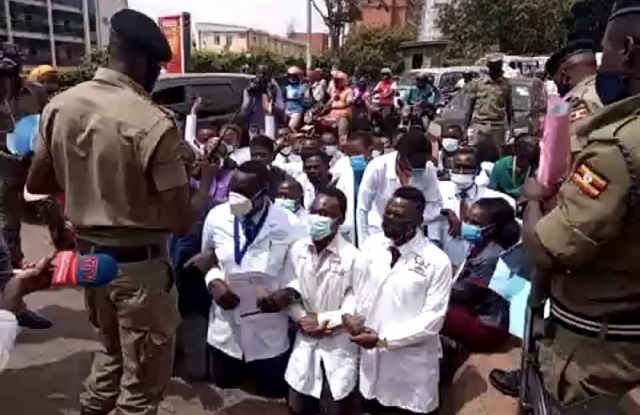
Kampala, Uganda | THE INDEPENDENT | One of the highlights of the year 2021 was in the health sector where several strikes by different health workers were called.
According to doctors, the strikes that are estimated to have lasted more than two months will not be the last that the country will see. They predict that the troubles in the health sector are likely to increase and more strikes organised by different health cadres should be expected.
This comes days after doctors under the Uganda Medical Association called off their five-week strike that left many patients stranded. With medical interns also on strike and later joined by pharmacists and laboratory attendants, services at health facilities were crippled.
While many of the groups later called off the strikes, the damage was already done. Dr Herbert Luswata, the secretary-general of UMA says while there are no reports of deaths that occurred due to the absence of doctors, many chronic illness cases deteriorated.
“Reports that we have show that the health condition of many people suffering from diseases like diabetes and hypertension worsened because there were no doctors to attend to them, many went to clinics but there were no health workers to assist them,” Luswata said.
Despite this grim picture, doctors say such scenarios will most likely occur again due to the limited financing of the health sector.
Dr Mukuzi Muhereza, a member of UMA and also the secretary-general during the 2017 medical strike predicts that medical strikes will likely become a permanent fixture in the country unless government is willing to improve funding to the health sector.
“We went on strike in 2017 but some of the things we were demanding have never been seen,” he said. “At the time, we wanted medical equipment like sundries to be provided in hospitals. We wanted increase in salaries so that the lowest cadre earns 5 million shillings. Most the things we were striking for have never been fulfilled despite government promises. The UMA executive met government and again promises were given but unless more is invested in health, doctors’ demands will remain unfulfilled promises that will spark more strikes,” he said.
According to Muhereza, their strike led to the increase in the allocation towards procurement of medicine and medical equipment like sundries. Other issues like salary increment have however been pending for the last four years despite the government promising at the time to have a clear plan to meet all their demands by the end of July 2018.
This year, the health workers’ strikes began in May with the medical interns under the Federation of Uganda Medical Interns demanding that government improve their working conditions by providing them with PPE and increment of allowances from 900,000 shillings to 2.5 million shillings.
The interns who do over 80 percent of the work at health facilities were convinced to resume work in July following a meeting with President Yoweri Museveni. During the meeting, it was agreed that interns be paid more. As expected, this meeting was followed by a lengthy letter signed by the president addressed to the finance ministry to look for funds to meet the demands of the interns. However, by November 2021, this directive had never been implemented which led the interns to lay down their tools once again.
Dr Luswata describes the failure of the government to implement the directives of the President as a match stick that can light the next bush fire, which in this case means the already few doctors laying down their tools.
The 2017 and 2021 health worker strikes are not the first that have been launched by doctors in protest of poor working conditions. UMA that was formed by Sir Albert Cook in 1917, as a branch of the British Medical Association has led several strikes.
In his book titled, ‘Uganda’s Health Sector Through Turbulent Politics(1958-2018)’, Anthony K Mbonye says,’ the Uganda Medical Association has been bedeviled by financial constraints, frequent strikes by its members pressing for better pay, as well as ideological and political differences. Subsequent governments, particularly that of Idi Amin and during President Obote’s second tenure have persecuted doctors,” an excerpt reads.
One of the instances involving health worker strikes in the book is a 1963 incident that made nurses at Mulago threaten to call a strike after the government at the time dismissed 160 trainee nurses and midwives who refused to wear identification badges while on duty. The badges had been introduced as a means to eradicate impersonators who were fond of cheating unsuspecting patients.
Both Luswata and Mukuzi say the implementation of the Abuja declaration, the allocation of 15 percent of the country’s national budget, is the holy grail or solution to stop these strikes. However, Prof Francis Omaswa, a seasoned doctor and a member of the UMA elders council who also happens to be a ministry of health consultant disagrees.
Prof Omaswa says financing of the health sector should not be based on the Abuja declaration but rather contributions that are made per capita or person.
He intimates that if countries like Uganda are to increase investments in the health sector, the government should calculate monies contributed per person and not just a block-figure.
At the time of the passing of the Abuja declaration, estimates carried out by the World Health Organisation showed that contributions of USD 50 per person were needed. This figure today stands at 86 dollars per capita. Prof Omaswa says if the government used the per capita system, the implementation of policies like the national health insurance scheme would be able to happen.
****
URN
 The Independent Uganda: You get the Truth we Pay the Price
The Independent Uganda: You get the Truth we Pay the Price




they strike cos of the oppression they get from the rues set by the department. its even very sad to see many trained health workers leaving the country to go work abroad.